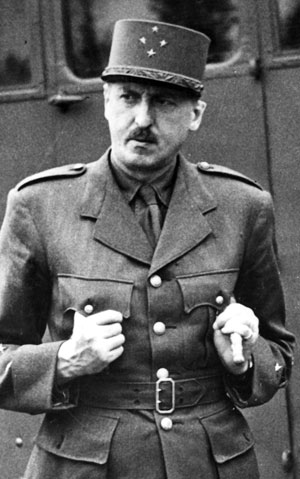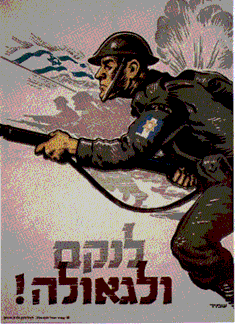|
The First Salute
By Jerry Klinger
"We were neither saints nor knights. We were simple Israeli boys who understood that we stand now for the Jewish people..." Hanoch Bartov1
The first break of the sun, Sept. 1, 1939, German tanks raced across the plains of Poland slaughtering the heroic, insane cavalry charges of the outdated Polish army. It was over in a few weeks. Poland was invaded from the West by the Germans and from the East by the Russians. The Jews were caught in the middle of horrific, long, long blood filled night.
May 17, 1939, the British government of Neville Chamberlin issued the White Paper. Surrendering to Arab pressure and hoping through appeasement that Arab anti-British sentiment would be curtailed, Jewish immigration to Palestine was virtually cut off. Just as European Jewry was increasingly desperate for any place that would give them refuge from death, the British closed the door of escape. The Holocaust had arrived. David Gen Gurion bitterly declared: "We will fight the White Paper as if there is no war and fight the war as if there is no White paper."
The British were highly resistive to letting Palestinian Jews fight; the realities of war changed their minds. The Arabs protested loudly, but the British needed men.
Of the 460,000 Jews in Palestine, 30,000 served with the British armed forces. Of the 1,600,000 Arabs in Palestine, 9,000 served.
Fifteen Palestinian Jewish battalions were authorized in 1940. The Jewish battalions were quickly sent to Greece. 100 Palestinian Jews were killed and 1,700 taken prisoner by the Germans. The fate of the Jewish War prisoners……..
Desperate for reliable manpower, the British acquiesced and formally permitted the creation of the Jewish Brigade Group, September of 1944. 5,000 Palestinian Jewish Brigade volunteers fought under the flag of Zion. Led by Brigadier Ernest Benjamin, the Jewish Brigade fought against the Germans in Italy from March 1945 until the war ended in May 1945. In reality, smaller Jewish Palestinian battalions had been fighting for Britain actively in North Africa since 1941.
The war was not going well for the British in early 1942. Rommel and his Italian allies were pushing back the British relentlessly. Losses were staggering for the British. They were being decimated in Libya and needed to retreat, to regroup, rest and resupply. British loss, after loss, British defeat after defeat, the ability of retreating in order, without disaster, was very questionable. If the Allied forces could not retreat in an orderly manner, the North African war would be lost. It did not look good. A delaying action was ordered by the British high command.
In a remote area of the Libyan Desert, near an old Turkish fort, the Free French Forces were ordered to stand and fight. The fort was built near an oasis. It was called Bir Hakeim and was the key to the great port city of Tobruk. A line was drawn ahead of the Germans. The First Free French Division, led by legendary General Marie-Pierre Koenig was ordered to hold. The French dug in. Thousands of individual fox holes were dug. Mines were laid in thick fields to slow the Germans. The French waited. A British brigade, unknown at the time to General Koenig, was hastily sent to hold the far end of the French line near Bir-el Harmat. They were a battalion of mine layers, poorly armed and provisioned, without heavy weapons, or anti-aircraft equipment but with a grim, teeth clenched determination. They were a battalion of 400 Jewish Palestinians under the command of Major Liebmann from Tel Aviv. It was May 26, 1942. The Jewish fighters dug in.
A German tank column approached the heavily outnumbered and out gunned Jewish position.
Raising a flag of truce the German commander came near to the Allied position and demanded they surrender or be annihilated. Noticing the strange flag flying, the German asked who they were. To the amazement of the German officer, Major Liebmann told him they free Palestinian Jews fighting for the British government. They would not surrender. The flag was the flag of the Jewish people. It was June 2, 1942.
German 88mm canon opened up with terrible effect. German Stukas bombed and strafed, and bombed and strafed. Hundreds of sorties were eventually flown. German tanks advanced and attacked ferociously. Several were destroyed in the mine fields. A few penetrated the center of the lightly armed Jewish position. Jewish soldiers jumped on the tanks destroying them with Molotov cocktails, incinerating the German tank crews inside. Without even a radio to contact the French fighting a few miles up the line, the Jews held. Heavy black smoke billowed from the burning German tanks as the Germans retreated; their dead left on the hard, dry desert.
German and Italian armor attacked again and again on June 5 and June 6. The Jewish position held. Daily the Stukas bombed the Jews. German artillery was unrelenting, eventually destroying the Jewish water source. Still the Jewish position held refusing to surrender, even without water. Astonished the Germans continued attacking with no success. The Jews refused to surrender or be conquered.
June 10: Orders from the British 8th Army reached the French at Bir Hakeim and the Jews at Bir-el Harmat: retreat. The British 8th Army was safe. It had retreated in good order with its equipment and supplies. The delaying action could be called off. In the dark of the night of June 11, the French and the Jews slipped away, unbeknownst to the Germans. They had done the impossible.
Over the next few months, the reorganized and reequipped British 8th Army fought and defeated Rommel's famed Africa Corps at El Alamein. It was the beginning of the end for the Germans and their Italian allies in North Africa. The bloody tide of war had changed.
General Koenig watched as the ragged, unknown Allied survivors from the far end of the line staggered in to the French command center at Gasr-el-Abid. They dragged their wounded as best they could. Major Liebmann reported to a concerned General Koenig. Speaking in perfect French, he told General Koenig they were Jewish Palestinian soldiers. Of the 400 men who made up the battalion, over three hundred, 75%, had been killed or wounded. They were the survivors.

General Marie-Pierre Koenig
The General observed their flag flying proudly. It was being taken down and folded by a very tired Jewish soldier.
What is that man doing? Koenig demanded of Liebmann. Liebmann told the French General that British regulations did not let them fly their flag, the blue and white flag with the Star of David. The British did not want to see it. An instant command was barked. General Koenig ordered the soldier to stop folding the flag. Koenig ordered it placed on the front of his Jeep to fly next to and equal to the flag of France.
Turning to his officers, Koenig ordered all his soldiers to stand at attention and salute as the flag of the future state of Israel went by. It was the first Salute.
General Koenig remained a committed friend and advocate on behalf of Israel for the rest of his life. In the lower Galilee, near Nazareth, trees grow in the soil of a free Israel; the Marie-Pierre Koenig Grove.
Jerry Klinger is President of the Jewish American Society for Historic Preservation
www.JASHP.org
1
http://www.olinfilms.com/brigade/resources/bios/bartov.html
~~~~~~~
from the October-November 2009 Edition of the Jewish Magazine
|
